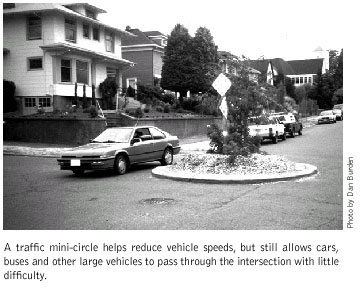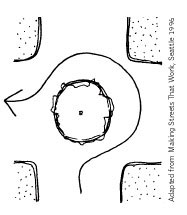27. Traffic Mini-Circles
Mini-circles are raised circular islands constructed in the center of residential street intersections. They reduce vehicle speeds by forcing motorists to maneuver around them and are sometimes used instead of stop signs. Mini-circles have been found to reduce motor vehicle crashes up to 93% in some locations, such as Seattle, WA. Drivers making left turns are directed to go on the far side of the circle (see diagram at right) prior to making the turn. Signs may be installed within the circle to direct motorists to proceed around the right side of the circle before passing through or making a left turn. Mini-circles are commonly landscaped (bushes, flowers, or grass), most often at locations where the neighborhood has agreed to maintain the plants. In locations where landscaping is not feasible, traffic circles can be enhanced through pavement materials.
Mini-circles are an intersection improvement as well as a traffic calming device and can take the place of a signal or four-way stop (many un-warranted signals are installed because of the demand for action by the community).
Mini-circles must be properly designed to benefit pedestrians and cyclists. Right-turning vehicles are not controlled at an intersection with a mini-circle, potentially putting pedestrians and cyclists at risk. Curb radii should not be reduced to what would be otherwise desirable. Traffic circles with splitter islands make crossing easier for pedestrians (especially the disabled) and control vehicle movements entering the inter-section, but require more space. The occasional larger vehicle going through an intersection with a traffic circle (e.g., a fire truck or moving van) can be accommodated by created a mountable curb in the outer portion of the circle.

 Purpose:
Purpose:
- Manage traffic at intersections where volumes do not warrant a signal.
- Reduce crash problems at the intersection of two local streets.
- Reduce vehicle speeds at the intersection.
- Treat a series of intersections along a local street as part of a neighborhood traffic improvement program.
Considerations:
- Do not make generous allowances for motor vehicles by increasing the turning radii , this compromises pedestrian and cyclist safety.
- Larger vehicles that need access to streets (e.g. school buses and fire engines) may need to make left hand turns in front of the circle.
- Use yield, not stop controls
Estimated cost
The cost is approximately $6,000 for a landscaped traffic mini-circle on an asphalt street and about $8,000-$15,000 for a landscaped mini-circle on a concrete street.